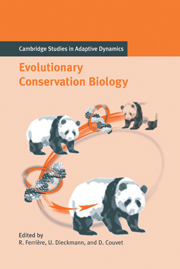Book contents
- Frontmatter
- Contents
- Contributing Authors
- Acknowledgments
- Notational Standards
- 1 Introduction
- Part A Theory of Extinction
- 2 From Individual Interactions to Population Viability
- 3 Age Structure, Mating System, and Population Viability
- 4 Spatial Dimensions of Population Viability
- Part B The Pace of Adaptive Responses to Environmental Change
- Part C Genetic and Ecological Bases of Adaptive Responses
- Part D Spatial Structure
- Part E Community Structure
- References
- Index
- The International Institute for Applied Systems Analysis
3 - Age Structure, Mating System, and Population Viability
Published online by Cambridge University Press: 15 August 2009
- Frontmatter
- Contents
- Contributing Authors
- Acknowledgments
- Notational Standards
- 1 Introduction
- Part A Theory of Extinction
- 2 From Individual Interactions to Population Viability
- 3 Age Structure, Mating System, and Population Viability
- 4 Spatial Dimensions of Population Viability
- Part B The Pace of Adaptive Responses to Environmental Change
- Part C Genetic and Ecological Bases of Adaptive Responses
- Part D Spatial Structure
- Part E Community Structure
- References
- Index
- The International Institute for Applied Systems Analysis
Summary
Introduction
The fate of populations depends on the life-history traits of the species and possible adaptive changes in these traits in response to selective pressure. In unstructured population models, life-history traits are compounded into few parameters, like the intrinsic growth rate r and the carrying capacity K (see Chapter 2). Structured population models, based on life-cycle graphs, allow the effects of specific life-history traits (survival rates, fecundities, generation time, age at maturity) on population dynamics to be investigated. For example, sensitivities of the growth rate to changes in life-cycle transitions can be computed. Individual life-history traits are important determinants of a population's extinction risk, and are also both factors in and targets of a population's adaptive response to environmental change.
When population size is small – always a concern in conservation biology – both individual life-history traits and the structure of interactions between individuals and the genetic system are expected to influence viability. The mating system, for example, may be conducive to an Allee effect (see Chapter 2), and inbreeding depression is a potentially important factor of the extinction process of small populations. In this chapter, we study the interplay between population structure, in terms of age and sex, and population persistence. Two-sex structured models that incorporate specific features of the social mating system and possible differences in male and female life cycles are analyzed. Also, attempts to merge genetic factors and demography into integrated models are presented.
- Type
- Chapter
- Information
- Evolutionary Conservation Biology , pp. 41 - 58Publisher: Cambridge University PressPrint publication year: 2004
- 14
- Cited by

